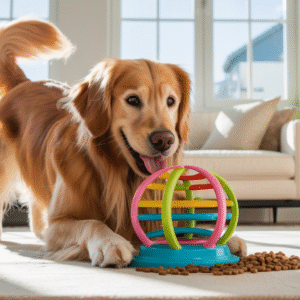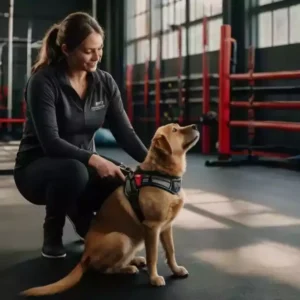
Imagine the thrill of hitting the open road or taking to the skies, your furry companion excitedly by your side. Travelling with your dog can be one of the most rewarding experiences. But, it can also come with its challenges. That’s where crate training becomes essential.
Understanding how to crate train a dog for travel can set the foundation for a smooth journey. It allows your dog to feel safe and secure no matter where you go. Not only does it help create a stress-free experience for both you and your pet, but it also ensures a level of comfort during long or unpredictable travel hours.
With the right guidance, you can turn what might be a daunting task into an enjoyable adventure. In this guide, we’ll explore easy steps to crate train your dog for travel. Making your next journey something to look forward to1.
Key Takeaways
- Crate training provides a safe space for dogs during travel.
- Establishing a positive association with the crate can ease anxiety.
- Choosing the right crate is vital for comfort and compliance.
- Gradual acclimatization is essential for successful crate training.
- Crate training is beneficial for both short trips and long journeys.
Introduction to Crate Training for Travel
Crate training is key for a smooth trip with your dog. It creates a calm space, making travel better for them. Dogs often like small, cozy areas, which makes crate training both useful and comforting2.
When your dog feels safe in their crate, it reduces stress in new places like cars and planes.
Begin crate training two to three months before your trip3. Introduce your dog to the crate slowly to ensure they like it. Start with short sessions, like 10 minutes, to help them get used to it2.
This training improves your dog’s behavior, preparing them for the journey.
Why Crate Training is Essential for Travel
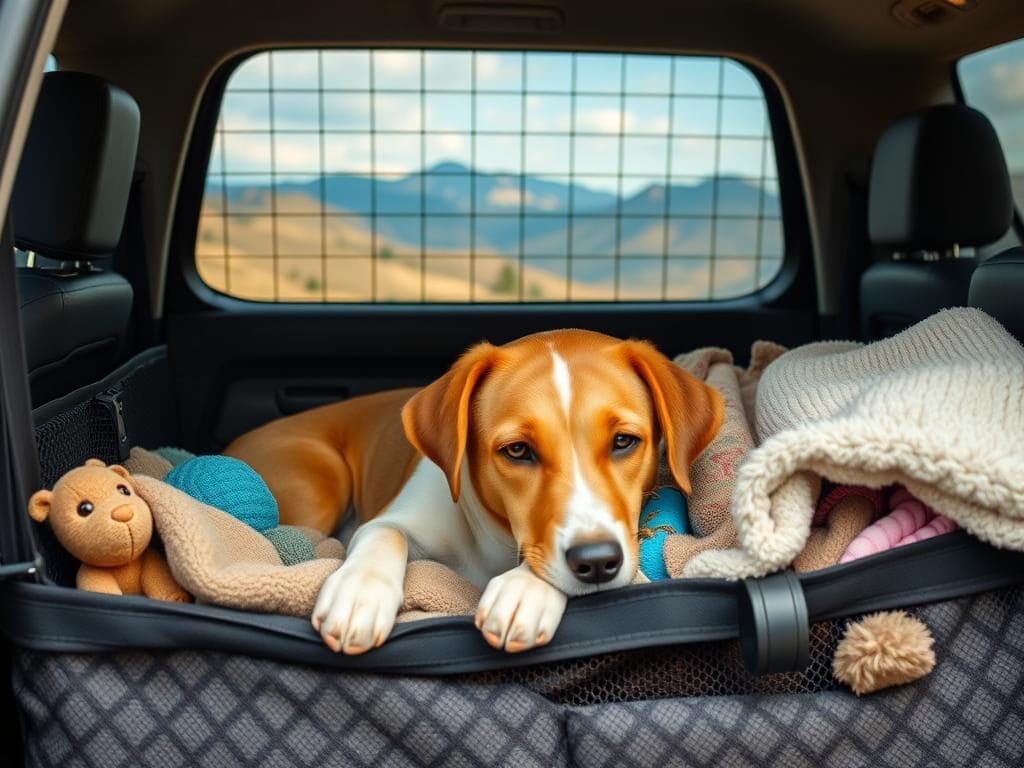
Crate training is key for your dog’s travel comfort. It offers a cozy space, which is comforting during long trips or in new places. Many experts, like vets and trainers, say crate training is crucial from a young age. It helps reduce your dog’s travel anxiety4.
With good crate training, your dog will feel less stressed during travel. This is great for dogs that get anxious easily5.
Benefits of a Crate for Your Dog
A crate offers many benefits for safe travel. It’s a safe spot for your dog to relax without distractions. Dogs usually don’t mess where they sleep, making crate training important for housebreaking4.
It also helps new dogs adjust by giving them a sense of security4.
Creating a Safe Environment on the Road
Keeping your dog safe during travel is important for both of you. A crate keeps your dog from moving around, which lowers the chance of accidents. It also helps manage your dog’s behavior and keeps them comfortable65.
In emergencies, having quick access to your dog is crucial. Regular crate use helps create a calm environment. This makes your dog feel secure while traveling.
Choosing the Best Crate for Travel with Dogs

Choosing the right crate for travel is key to your dog’s comfort and safety. There are many types of dog crates, each for different needs and preferences. Knowing these types helps pick the best crate for travel with dogs.
Understanding Different Types of Crates
When looking for the best crate for travel, you’ll find several types:
- Metal Crates: These are durable and well-ventilated, loved by 40% of dog owners7. They’re adaptable and come with dividers for dogs of all sizes and ages.
- Plastic Crates: 15% of dog owners choose these for air travel7. They offer solid walls and are lightweight, great for shy dogs.
- Fabric Crates: 20% of dog owners prefer these for small breeds7. They’re light and easy to set up but not as durable.
- Wooden Crates: About 55% of dog owners like these for their looks and as furniture7.
Crate Train Your Dog for Travel – Size and Comfort Considerations
Choosing the right size crate is vital for your dog’s comfort. Use a crate size guide to measure from the nose to the tail base when standing8. Add 2 to 4 inches for length. For height, measure from the floor to the head in a sitting position, then add 2 to 4 inches for space8.
Make sure your dog’s weight fits the crate’s limit for safe travel8. If for a puppy, estimate the adult size based on breed. Choose crates with divider panels for growing puppies9.
| Crate Type | Material | Portability | Durability | Best Use |
|---|---|---|---|---|
| Metal Crate | Metal | Moderate | High | Home, travel |
| Plastic Crate | Plastic | High | Moderate | Air travel |
| Fabric Crate | Fabric | Very High | Low | Short trips, small dogs |
| Wooden Crate | Wood | Low | High | Home, as furniture |
Each crate type has its purpose based on travel plans, dog size, and needs. Prioritize size, comfort, and material when choosing the best crate for travel with dogs798.
How to Crate Train a Dog for Travel

Learning how to crate train a dog for travel is key for a smooth trip. Start by making the crate a safe and positive space. Use treats and positive training to make your dog want to go in the crate. This way, they’ll see the crate as a cozy and safe spot.
Let your dog get used to the crate at their own speed. Increase the crate time slowly, making sure they feel safe. Add familiar items like toys and their favorite bed to make it cozy. This can help reduce stress, like when flying.
Short drives with the crate are great practice. They help your dog get used to moving without the stress of flying. Stay calm and patient, and don’t open the crate if your dog seems upset. Remember, the crate is for comfort, not punishment.
Always follow the right size guidelines for the crate10. This ensures your pet has enough room to move comfortably. By following these steps, you’ll make traveling a breeze for both you and your dog.
Step-by-Step Guide to Crate Training
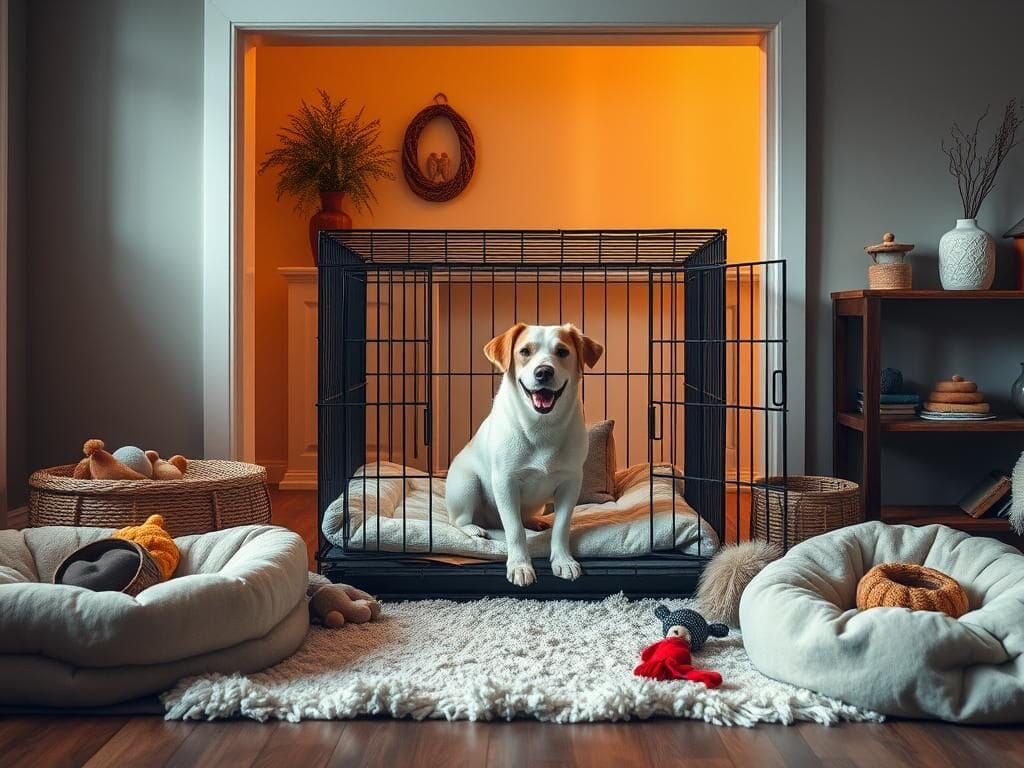
Crate training is key for getting your dog ready for travel. It makes the crate a safe and welcoming place. Here are the main steps for successful crate training.
Establishing a Positive Mindset
Begin by making a calm space for your dog. Your mood affects theirs. Be optimistic, as dogs sense their owner’s feelings.
A positive attitude helps your dog see the crate as a safe spot. Use tips that promote a calm atmosphere for better results.
Using Treats and Rewards
Use treats to encourage your dog during crate training. Give them treats when they show interest in the crate. This positive reinforcement helps them learn.
Keep treats ready and reward your dog for going into the crate. A tasty reward can make the crate a cozy place for them.
Gradual Acclimatization Techniques
Start with small steps to help your dog get used to the crate. Begin with short times and gradually increase it. This helps them feel less anxious and adjust better.
By following these steps, you’ll help your dog get used to the crate smoothly. Remember, patience and consistency are crucial in crate training11.
Tips for Traveling with a Dog in a Crate
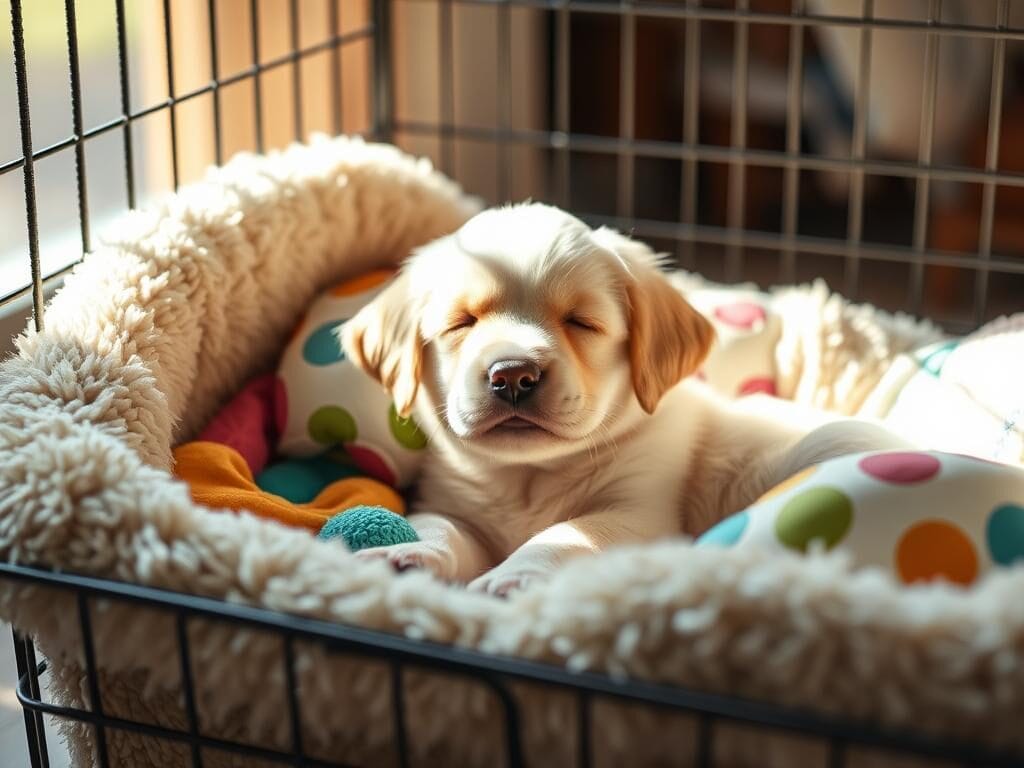
Traveling with a dog in a crate needs careful planning. You must think about your dog’s comfort and how to reduce their stress. Here are some important tips to make your trip better for both you and your dog.
Keeping Your Dog Comfortable
Choose a crate that lets your dog stand, turn, and lie down easily. Dogs need to feel safe in their crate, which is even more important when traveling12. Use familiar items like blankets or toys with their scent to help them relax. Don’t forget to give them water during breaks.
Managing Time Spent in the Crate
It’s important to watch how long your dog is in the crate. Give them breaks to move around and go to the bathroom, which is crucial on long trips. Studies show that crating can help dogs feel calmer13. Let your dog get used to the crate at home before the trip, starting with short times and increasing it14. This helps them adjust and makes crate training more effective12.
| Dog Travel Comfort Tips | Crate Management Strategies |
|---|---|
| Provide familiar items | Schedule regular breaks |
| Ensure proper ventilation | Monitor crate time closely |
| Use positive reinforcement | Gradually increase crate time at home |
| Keep the crate clean | Never leave the dog unattended in the car |
By following these tips, you can manage your dog’s crate time better. This will make sure they have a safe and fun trip141312.
Crate Training a Puppy for Travel
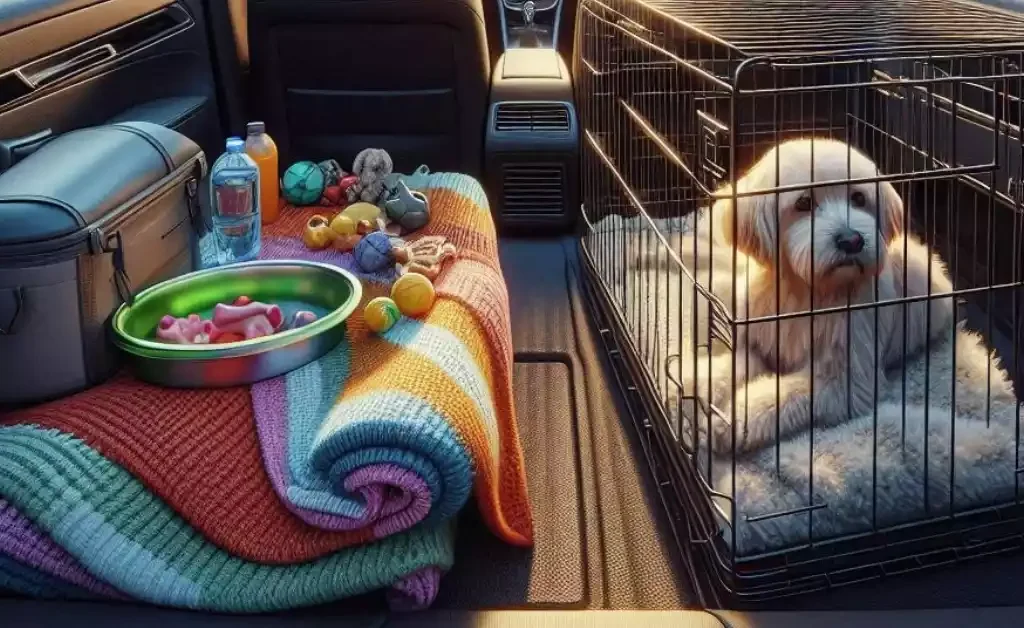
Starting crate training early is key for a good travel experience. Puppies learn fast and are easy to train. Early training makes crate life easier, including for travel.
Starting Early with Young Dogs
Early crate training works best. Puppies may need time to adjust to sleeping through the night15. Make the crate a safe spot for them. Adding familiar scents can make them feel more at home15.
Building Positive Associations
Make the crate a positive place with toys and treats. Start slow with crate training. Let your puppy explore the crate freely during the day15.
Use praise and treats when they go into the crate willingly. Never punish them in the crate. This way, they see it as a cozy space, not a jail16.
| Consideration | Details |
|---|---|
| Crate Size | The crate must be large enough for the puppy to stand, turn around, and lie down comfortably16. |
| Material | At least metal or a sturdy plastic, as soft or collapsible crates may not provide adequate security for travel17. |
| Comfort Features | Including familiar blankets or items that smell like home can help improve puppy comfort in crate16. |
| Training Duration | Crate training can take days to weeks; patience is key16. |
| Separation from Litter | Puppies may whine due to missing their littermates; understanding this will help you respond correctly15. |
Dog Crate Training Tips for Road Trips
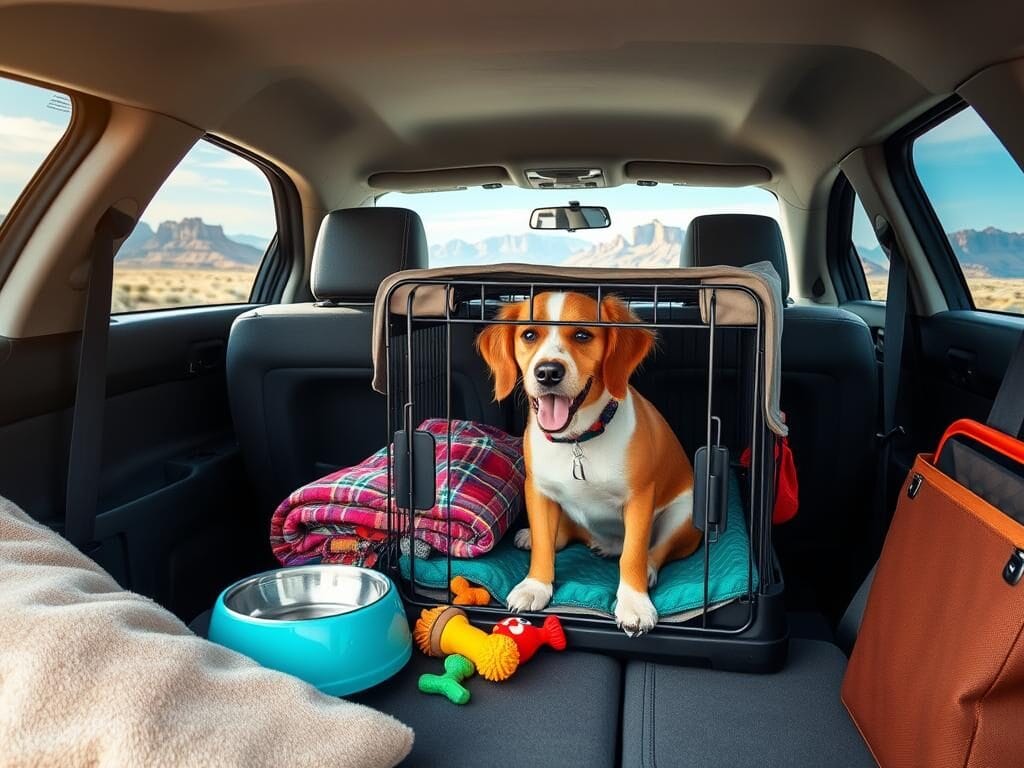
Getting your dog ready for travel means using good crate training tips for road trips. Begin with short crate sessions to make your dog feel safe in their crate. This gradual training helps them get used to being in the crate.
Short Duration Trials Before Long Trips
Short trips around the block are great for getting your dog ready for longer ones. Place your dog in the crate for these short trips. Use treats to make them happy about being in the crate.
Start with short trips and then move to longer ones slowly. This lets your dog get used to the car without stress.
Familiarizing Your Dog with Car Travel
Make car travel fun for your dog. Add their favorite bedding, toys, and chew items to the crate. This helps them feel at ease and less anxious18.
Give them treats or playtime after arriving at your destination. This makes them look forward to car rides. About 70% of dogs learn to like the crate in just one day with the right approach19.
Make sure your dog can stand, turn, and lie down in the crate. This keeps them safe and comfortable during the trip19.
| Activity | Duration | Tips |
|---|---|---|
| Short Crate Sessions | 10-15 minutes | Use treats for positive reinforcement. |
| Gradual Car Trips | 15-30 minutes initially | Include familiar toys for comfort. |
| Longer Road Trips | 1 hour or more | Take breaks for bathroom and water. |
Airline Travel with a Crated Dog
Traveling by air with a crated dog needs careful planning and following rules. Knowing the air travel rules for dogs is key to keep them safe and comfy. Airlines have specific IATA crate rules to make boarding easy. This includes knowing carrier size limits and getting the right health papers20.
Preparing for Air Travel Regulations
It’s important to know the weight and size rules set by airlines. Dogs in the cabin can’t weigh over 20 pounds, including the carrier. Carriers should be about 18″ long, 11″ wide, and 11″ high21. Also, some dog breeds may need extra care in hot weather20.
Choosing the Right IATA-approved Crate
Choosing the right IATA-approved crate is crucial for a safe and comfy flight. Many prefer soft-sided carriers for their lightness and ease of use. They also have mesh for air and are easy to fold up21. Don’t forget, a health certificate is often needed. Learning how to crate train your dog can make flying less stressful for them22.
🎯 Ready to Unlock Your Dog’s Hidden Intelligence? Start Training Now!
Transform crate training and every interaction with your dog into a bonding experience with a highly effective, science-backed approach to obedience. Learn directly from a certified professional dog trainer!
Why Dog Owners Love Brain Training for Dogs:
- Proven Expertise: Developed by Adrienne Farricelli, a CPDT-KA certified trainer with over a decade of experience in transforming canine behavior.
- Science-Based Techniques: Training strategies based on positive reinforcement and designed to tap into your dog’s natural intelligence.
- Easy, Step-by-Step Guidance: Video tutorials and detailed instructions make it easy for any dog owner to follow along.
- Improves Obedience and Reduces Stress: Perfect for crate training and curbing unwanted behaviors – even on the go!
- Enhances Bonding and Connection: Build a deeper relationship with your dog while guiding them toward better behavior and calmness.
- Lifetime Access: Learn and train at your own pace, with unlimited access to resources and techniques for every stage of your dog’s life.
🎉 Don’t Wait – Begin Your Journey to a Happier, Smarter, and More Obedient Dog Now!
FAQ
How do I start crate training my dog for travel?
To start crate training, put treats and toys in the crate. This makes it a positive space. Increase crate time slowly, rewarding calm behavior.
What is the best crate for travel with dogs?
The best crate is durable, airline-approved, and the right size for your dog. It should allow your dog to stand, turn, and lie down comfortably.
How can I keep my dog comfortable during long travel periods in a crate?
To keep your dog comfortable, add familiar items like blankets or toys. Give regular breaks and ensure water access. Watch crate time to let them stretch and relieve themselves.
What are some crate training tips for traveling with a puppy?
Introduce your puppy to the crate early with positive reinforcement. Use short, positive sessions. Focus on making them comfortable with the crate.
How can I prepare my dog for airline travel in a crate?
For airline travel, choose an IATA-approved crate that fits airline rules. Make sure it’s well-ventilated and secure. Practice short stays to reduce anxiety.
Why is crate training important for travel?
Crate training is key for travel. It gives your dog a safe space, reducing anxiety. A well-trained dog travels better, by car or plane.
How long should I keep my dog in the crate while traveling?
The crate time depends on your dog’s age, size, and comfort. Adult dogs can handle 4-6 hours. Puppies need breaks more often. Always check your dog’s comfort and plan breaks.
Source Links
- https://www.coastalpet.com/blog/how-to-crate-train-your-dog-for-a-stress-free-experience/?srsltid=AfmBOopySNOFSMUOlIIDY3oXd4jaSUSUuYLpVO615YFMEgWTkZdPvWHn – Coastal Pet Products
- https://www.akc.org/expert-advice/training/how-to-crate-train-your-dog-in-9-easy-steps/ – No title found
- https://www.airpets.in/blogs/how-to-crate-train-your-pet-for-a-stress-free-travel – How to Crate Train Your Pet for a Stress-Free Travel – Pet Travel Blog | Pet Friendly Travel Blog
- https://www.akc.org/expert-advice/training/why-crate-training-is-great-for-your-dog/ – No title found
- https://www.lnfweekly.info/stories/to-crate-or-not-to-crate-231017 – To crate, or not to crate? | LNF Weekly
- https://www.playtimepaws.com/crate-training-how-why/ – YNP #005: Crate Training: How (and Why) to Make Their Crate Your Dog’s Best Friend – Playtime Paws
- https://www.akc.org/expert-advice/lifestyle/choose-best-crate-dog/ – No title found
- https://www.preventivevet.com/dogs/how-to-measure-and-choose-a-dog-crate – Choosing the Best Dog Crate for Your Dog | Preventive Vet
- https://www.vet.cornell.edu/departments-centers-and-institutes/riney-canine-health-center/canine-health-information/dog-crates-when-use-them-and-how-pick-one – Dog crates: When to use them and how to pick one
- https://petraveller.com.au/blog/how-to-crate-train-your-pet-for-travel – How to crate train your pet for travel
- https://be.chewy.com/how-to-crate-train-a-puppy-a-step-by-step-guide-from-an-expert/ – How to Crate Train a Dog: A Step-by-Step Guide From an Expert
- https://www.acrossthepondpet.com/resources/blog/59-from-home-to-travel-the-benefits-of-crate-training-your-dog-tips-for-crate-training-your-dog – The Benefits of Crate Training Your Dog & Tips for Crate Training Your Dog
- http://www.sadiesrulesk9training.com/blog-posts/2019/6/29/how-to-crate-train-your-dog-and-why-you-should – How to Crate Train Your Dog (and Why You Should!) — Sadie’s Rules K9 Training
- https://www.coastalpet.com/blog/how-to-crate-train-your-dog-for-a-stress-free-experience/?srsltid=AfmBOooe50PPME96rTiajrQC2gX15t4bgJUfb18jaFSBveJBlUC9OGt4 – Coastal Pet Products
- https://www.poodleforum.com/threads/crate-training-travel-carrier.287489/ – Crate Training & Travel Carrier
- https://www.petmd.com/dog/general-health/crate-training-puppies – How to Crate Train a Puppy
- https://www.coastalpet.com/blog/how-to-crate-train-your-dog-for-a-stress-free-experience/?srsltid=AfmBOoqRG6NEgt79BXN1tf7pnExPI50f-cW2nJm9Ok8h91jvt7Jid2jW – Coastal Pet Products
- https://www.thule.com/en-us/articles/guides/introducing-your-dog-to-a-car-crate – Introduce Your Dog to a Car Crate: Effective Training Tips | Thule
- https://www.drjensdogblog.com/crate-training-your-dogs-portable-safe-haven-and-how-to-help-him-love-it/ – Crate Training: Your Dog’s Portable Safe Haven, And How To Help Him Love It
- https://www.iata.org/en/programs/cargo/live-animals/pets/ – Traveler’s Pet Corner
- https://gatorandnuthin.com/the-ultimate-guide-to-flying-with-a-dog/ – The Ultimate Guide to Flying With a Dog – Gator and Nuthin
- https://www.starwoodpet.com/blog/how-to-crate-train-your-pet-for-airplane-travel – How to Crate Train Your Pet for Airplane Travel

